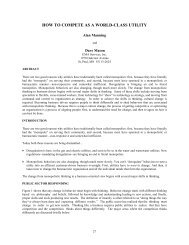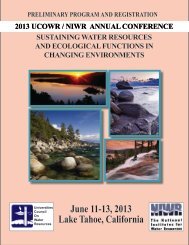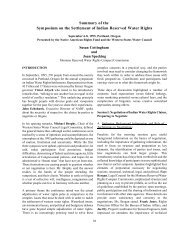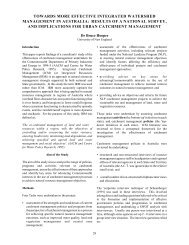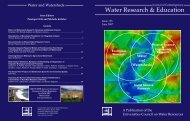Full Journal of Contemporary Water Research and Education, Issue ...
Full Journal of Contemporary Water Research and Education, Issue ...
Full Journal of Contemporary Water Research and Education, Issue ...
You also want an ePaper? Increase the reach of your titles
YUMPU automatically turns print PDFs into web optimized ePapers that Google loves.
IWRM Curriculum in the United States113class, distance learning provides a viable substitute.It also provides a flexible option for a pr<strong>of</strong>essionalworkforce that is either in the field for extendedperiods or working long hours. Some individuals,however, felt that it was simply not suited to thefield <strong>of</strong> IWRM.ObservationsThe responses to the survey, particularly thewritten ones, suggest a vibrant interest in IWRMin the U.S. In many instances, there are opposingviews as to where the discipline should be focused<strong>and</strong> who bears responsibility for its design <strong>and</strong>execution. There is a clearly recognized need topromote inter-disciplinary approaches to waterresources management. The recurring argumentbetween engineers, environmentalists, economists,<strong>and</strong> political science approaches to water resourcesmanagement was evident in the responses.Rivalries between these disciplines will in alllikelihood persist. The IWRM process provides ameans to achieve a balanced perspective, <strong>and</strong> itwas clear that many <strong>of</strong> those completing the surveyrecognize that strength. As always, the devil is inthe details, <strong>and</strong> further challenges exist in:• Gaining a fuller appreciation <strong>of</strong> what constitutesIWRM in the U.S.• Devising an IWRM curriculum that is trulymulti-disciplinary <strong>and</strong> addresses practitioner• Defining the roles <strong>of</strong> the public <strong>and</strong> privatesector in the educational process• Creating incentives that attract more studentsto the field <strong>of</strong> IWRM• Identifying research opportunities that promoteIWRM principles• Making more people aware <strong>of</strong> the importance<strong>of</strong> IWRM <strong>and</strong> the various training opportunitiesthat exist.Possible Next StepsWhile some <strong>of</strong> the respondents maintained thatIWRM training should be market-driven, the vastmajority felt that further incentives are in order.In considering whether or not to build upon thefoundation laid by the Corps <strong>and</strong> a few universities,key questions emerge that merit further exploration,namely:• Is there a need to develop guidelines onwhat constitutes a given university’s IWRMprogram?• Which incentives, if any, should be promoted todevelop sustainable IWRM training programs?• What incentives are needed to sustain a multiuniversityapproach should it prove to bewarranted?• What exceptions are allowable to attracta broad-based network <strong>of</strong> researchers <strong>and</strong>practitioners?Several respondents suggested that a workshop toaddress these issues is warranted, <strong>and</strong> the need toprepare a broadly acceptable approach defining<strong>and</strong> using IWRM. Ideally, such a workshop wouldbe attended by a balanced blend <strong>of</strong> academicianswho can address the course requirements, <strong>and</strong>practitioners who can speak to the training needs<strong>of</strong> their respective organization. At the federallevel, agencies such as the Bureau <strong>of</strong> Reclamation,the Environmental Protection Agency, the U.S.Geological Survey, the Department <strong>of</strong> Energy, theNational Resources Conservation Service, <strong>and</strong> theBureau <strong>of</strong> L<strong>and</strong> Management all play major rolesin water resources management. State <strong>and</strong> regionalinterest groups are also critical players in issuesframing IWRM training <strong>and</strong> educational programsthat more fully address practitioner needs.The primary focus <strong>of</strong> this particular surveyrelated to training <strong>and</strong> educational needs internalto the United States. International organizations,such as the Global <strong>Water</strong> Partnership, have madegreat strides in recent years in terms <strong>of</strong> advancingthe principles <strong>of</strong> IWRM. They also need to betaken into account as we struggle to customizeIWRM to suit needs peculiar to the U.S.Endnotes1.2.3.The participating universities include: the University<strong>of</strong> Arizona, the Johns Hopkins University, theUniversity <strong>of</strong> Florida, Southern Illinois UniversityCarbondale, <strong>and</strong> Harvard University.Those who developed the survey were: PaulBourget, David DeWalle, Richard Engberg, GeraldGalloway, <strong>and</strong> Ari Michelsen.The entire list <strong>of</strong> specialty areas consisted<strong>of</strong>: water quality, water supply <strong>and</strong> security,legal/institutional aspects, water resourcesJOURNAL OF CONTEMPORARY WATER RESEARCH & EDUCATIONUCOWR



